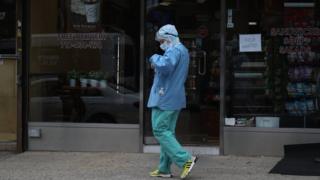 Image copyright
Image copyright
Getty Images
The number of Americans filing for unemployment has surged to a record high as the economy goes into lockdown due to the coronavirus pandemic.
Nearly 3.3 million people registered to claim jobless benefits for the week ended 21 March, according to Department of Labor data.
That is nearly five times more than the previous record of 695,000 set in 1982.
The rush overwhelmed many state offices handling the claims and signalled an abrupt end to a decade of expansion.
The shift comes as officials in states across the country close restaurants, bars, cinemas, hotels and gyms in an effort to slow the spread of the virus. Car firms have halted production and air travel has fallen dramatically. According to economists, a fifth of the US workforce is on some form of lockdown.
Analysts said the situation could be even worse than the data currently shows, noting the reports of jammed call lines and crashing state websites. Some kinds of workers, such as people working part-time, do not qualify.
“I’ve been writing about the US economy … since 1996, and this is the single worst data point I’ve seen, by far,” said Ian Shepherdson, chief economist of Pantheon Economics.
Nationally, the figures are nearly five times higher than the worst point of the 2008 financial crisis.
In Illinois, weekly jobless claims increased 10-fold. They more than quintupled in New York and more than tripled in California, which were among the earliest and biggest states to impose restrictions. The effects were even more dramatic in smaller states.
While some retailers, such as Walmart and Amazon, have announced plans to hire, economists said that will not make up for the jobs lost. As incomes evaporate, the economic damage is likely to snowball, since consumer spending accounts for the majority of the US economy.
“Once the risks around the virus pass, it will not be just easy to flip the switch and employment returns to pre-crisis levels,” Joseph Brusuelas, chief economist at RSM wrote on Twitter. “That is not how this is going to work and will require more aid.”
In Washington, Congress is expected to pass a more than $2tn (£1.7tn) stimulus bill, which includes direct payments of $1,200 (£999) to adults, an expansion of unemployment benefits, and financing for affected industries, such as airlines. The Federal Reserve has also taken unprecedented steps to shore up the economy.
But even with such action, a sharp economic contraction is inevitable, analysts said. Lower income workers are particularly vulnerable, as the lockdown forces retailers, fast food outlets and other low wage employers to cut back or close.
Mr Shepherson said he expects to see the unemployment rate increase to at least 6.5% shortly – nearly double the prior rate – and continue to accelerate in future months.
“Fed action and fiscal measures can only ameliorate the pain and we remain worried that the latter aren’t yet on a sufficient scale,” Mr Shepherdson wrote.
The US unemployment rate in February was hovering near historic lows at 3.5%. As recently as three weeks ago, the number of jobless claims was only about 210,000 and President Donald Trump was trumpeting the labour market’s health on Twitter.
Mr Trump, who has made the strength of the economy his political calling card, recently said he wants to loosen restrictions on activity as early as next month.
However, state and local officials worried about the rise in cases may decide not to follow the federal government as the number of cases continues to rise. The US had more than 69,000 cases as of Thursday.
In a television interview on Thursday, Federal Reserve Chair Jerome Powell said “the first order of business will be to get the spread of the virus under control and then resume economic activity”.
“The sooner we get through this period and get the virus under control, the sooner the recovery can come…We know that economic activity will decline probably substantially in the second quarter but I think many expect and I would expect economic activity to resume and move back up in the second half of the year,” he said.
The latest US unemployment numbers were predicted to be catastrophic. The actual total, 3.3 million, turned out to be even worse than expected.
The record-breaking amount reflects a US economy put into deep-freeze almost overnight. The government-ordered shutdown hasn’t just shuttered businesses temporarily, it has vaporised the jobs of millions of Americans – many of whom are the particularly vulnerable hourly service workers who live paycheque to paycheque.
The stock market free-fall and early reports of layoffs foreshadowed Thursday’s grim news, prompting Congress to craft its largest-ever aid package, which passed the US Senate on Wednesday night. The test now will be whether the multi-trillion-dollar relief will do enough, quickly enough, to stanch the bleeding.
What’s clear at this point, however, is the physical disease that is afflicting tens of thousands of Americans and growing will be accompanied by an economic ailment that adversely affects the lives of millions.





381583 263415I enjoyed reading this a lot I actually hope to read much more of your posts in the future, so Ive bookmarked your blog. But I couldnt just bookmark it, oh no.. When I see quality websites like this one, I like to share it with others So Ive produced a backlink to your site (from 143314
962248 798596Yeah bookmaking this wasnt a bad decision great post! . 241337
471022 140238Hi there! Wonderful stuff, please do tell me when you lastly post something like that! 992845
126515 842869You made some decent points there. I looked on the web for the dilemma and discovered most individuals will go coupled with along along with your site. 687827
757322 945838In todays news reporting clever journalists function their very own slant into a story. Bloggers use it promote their works and many just use it for fun or to stay in touch with friends far away. 335799
428072 753080Real great information can be found on web weblog . 241944
747672 28692As I website possessor I believe the content material here is rattling great , appreciate it for your hard work. You should keep it up forever! Good Luck. 344075
989844 847195I adore your wp style, wherever did you download it via? 969012
918798 805029Its excellent as your other posts : D, regards for posting . 768431
764799 180180A person necessarily lend a hand to make severely posts Id state. This is the really initial time I frequented your web page and to this point? I surprised with the analysis you made to make this particular submit extraordinary. Magnificent process! 811213
105951 528164you make running a blog glance 300210
841837 762152We stumbled over here coming from a different internet page and thought I may check things out. I like what I see so now im following you. Appear forward to exploring your web page yet again. 433569
247172 25116Thanks for all your efforts which you have put in this. quite interesting info . 678401
360769 127016Echt tolle Seite. Rubbish bin eigentlich nur per Zufall hier gelandet, aber ich bin jetzt schon complete von der tremendous Seite beeindruckt. Gratuliere dazu!! Viel Erfolg noch durch der sehr guten Home-page mein Freund. 611625
915040 834998Get started with wales ahead almost every planking. Ones wales truly are a compilation of huge planks one particular depth advisors definitely may be the identical towards the entire hull planking nonetheless with even larger density to successfully thrust outward beyond the planking. planking 334117
322077 592435I truly treasure your piece of function, Wonderful post. 354814
800514 872819There will likely be several entirely different portions about the LA Weight reduction eating strategy and 1 is really essential. Begin stage is your in fact truly of these extra load. weight loss 435470
186807 137566Woh I like your posts , saved to fav! . 985855
154297 771324I undoubtedly did not realize that. Learnt something new today! Thanks for that. 890776
690547 109725I enjoy your writing type, do keep on writing! Ill be back! 109463
891722 88882Wow, incredible weblog layout! How long have you been blogging for? you make blogging appear effortless. The overall look of your website is fantastic, as nicely as the content material! xrumer 552555
600435 25009Taylor Lautner By the way you might want to look at this cool website I found 161084
56164 108406Aw, this became an incredibly good post. In thought I would like to devote writing such as this moreover – taking time and actual effort to make a very great article but exactly what do I say I procrastinate alot and by no means discover a strategy to get something completed. 778360
333003 937349Some times its a pain within the ass to read what people wrote but this web site is real user genial ! . 629158
715015 928511Thank you for your quite great information and respond to you. 789468
… [Trackback]
[…] Read More here to that Topic: famousreporters.com/us-unemployment-claims-hit-record-amid-coronavirus/ […]
538925 377298There is evidently a great deal to know about this. I consider you produced certain nice points in attributes also. 427590
163491 336561It can be difficult to write about this subject. I believe you did an outstanding job though! Thanks for this! 427235